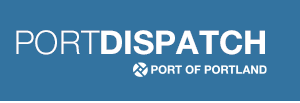In 2012, the Port of Portland’s marine franchise recorded notable calendar year gains in steel and auto volumes despite disruptions related to a jurisdictional dispute and contract negotiations in the latter half of the year. While the 12.4 million tons handled last year was a decrease of about eight percent, it was also the sixth best tonnage year on record.
Auto volumes showed a gain of 21 percent with 284,138 vehicles handled last year. The double digit increase was thanks in part due to recovery from the impacts of 2011 disasters in Japan and Thailand. The increase was also attributable to the first American-made auto exports to roll across the docks in Portland since 1988, with the addition of Ford as a new customer.
Breakbulk tonnage increased by five percent from last year to nearly a million tons. This is primarily steel slab and steel rail imports, and the Port also handled barite ore used for industrial drilling and various large scale project cargo at Terminal 2.
At the container terminal, 2012 began with the addition of carrier Hamburg Süd in February and an expanded, weekly service in partnership with Hapag-Lloyd. ICTSI Oregon, Inc., the Port’s terminal operator at Terminal 6, was selected for the Mayor’s Foreign Direct Investment Business Award in May. The terminal saw a total of 183,203 containers last year, which constitutes an eight percent decrease from the previous year.
Starting in late May, the container terminal experienced slowdowns related to a jurisdictional dispute between the International Longshore and Warehouse Union and the International Brotherhood of Electrical Workers over jobs involving the plugging, unplugging and monitoring of refrigerated containers. This is now being handled in federal court. A separate matter involving contract negotiations with Marine Security Officers was successfully resolved.
Contract negotiations between the Pacific Northwest Grain Handlers Association and the ILWU have yet to reach resolution, but the Port has no role in that process. Grain tonnage decreased by 15 percent to just over four million tons, but volumes should increase with expansion of the grain elevator at Columbia Grain’s Terminal 5 facility. This recent announcement accompanied a 25-year lease extension, and will involve an investment of approximately $40 million.
Mineral bulks – primarily potash used in fertilizer, and soda ash used in glass production – dropped by eight percent, to 4.8 million tons. The soda ash export facility at Terminal 4 will soon be home to a new, $8 million ship loader, supporting plans to boost efficiency and capacity.
Completion of South Rivergate Yard in August marked the last in a series of four major rail and road improvement projects in Rivergate Industrial District. The $11 million rail yard expansion was funded by the Port, ConnectOregon II funding, Union Pacific and BNSF Railway. Improving freight mobility and rail velocity makes the bulk facilities at marine Terminal 5 more competitive.
ConGlobal Industries moved its container depot to Rivergate in May to reduce drayage costs for customers and improve shipping operations. They were soon followed by construction of a rail-served sweetener plant for Archer Daniels Midland Company and a newly leased facility for Northwest Cascade, Inc. Other significant Rivergate leases included Exel Logistics in Bybee Lake Logistic Center, and OIA Global Logistics in Rivergate Logistics Center.
As regional studies underscore the need for more shovel-ready, large lot industrial land parcels, the Port is taking action. In October, the Troutdale Planning Commission approved a new Phase II subdivision in Troutdale Reynolds Industrial Park, adding to what will be a total of 12 lots on 314 acres. Nearby, Gresham Vista Business Park officially joined Oregon’s Certified Industrial Site program to market 11 developable lots on 203 industrial acres and 17 commercial acres.
Related Links:
